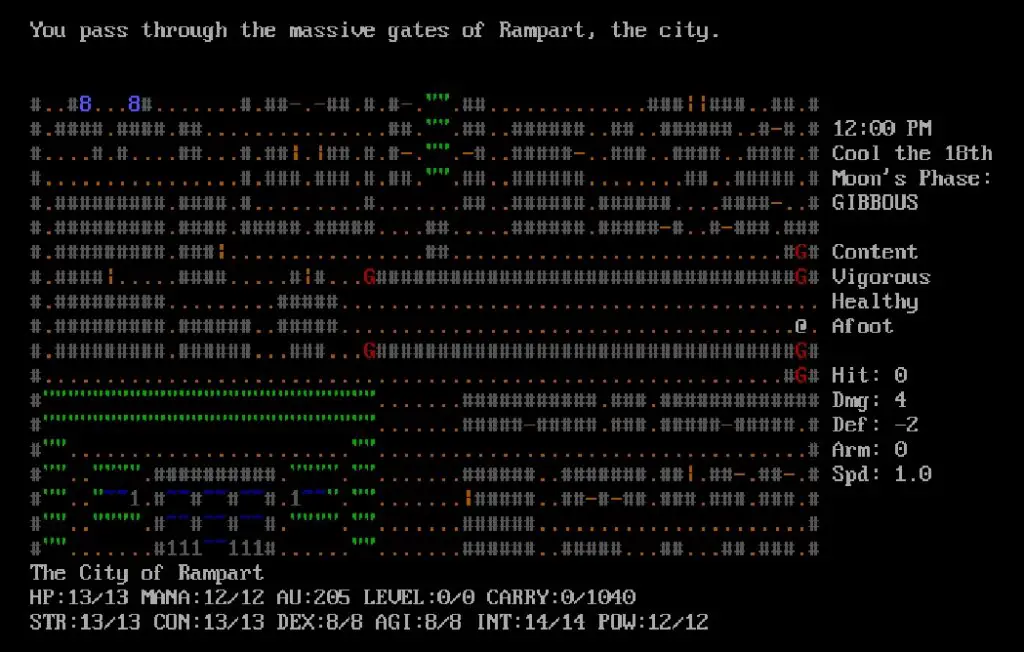
Introduction
There’s been a lot of discussions, lately, as to the precise definition of the term Roguelike. The often-asked question is whether the modern games bear any resemblance to the original classics. There were, of course, many attempts to nail down the exact features of the genre. Procedural generation, grid-based movement and turn-based combat are often at the top of such lists.
I’ll make no such attempt here.
Instead, it’s my hope that we can find the answers together, as we set forth on a journey across the shadows of time, from the dark age of text-based monochrome terminals and glowing CRT screens to the modern times of beautiful graphics and elaborate user interfaces. To take a look at some of the greatest works in the genre and to devise our own impression of what makes a game a Roguelike.
The Classics
Rogue (early 1980s)
On roguebasin: http://www.roguebasin.com/index.php/Rogue
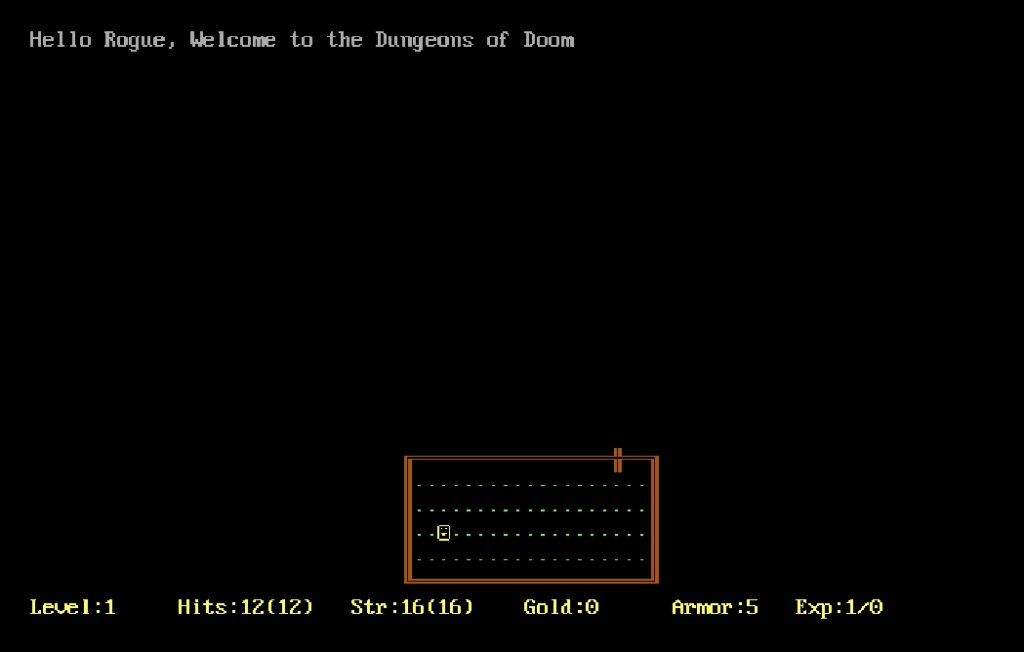
While, likely, not the first roguelike, it, nevertheless, gave the name to the whole genre. Therefore, it is here where our journey shall start. Rogue’s world is grim and dark. A lone hero in a deep dungeon, surrounded by foes. There’s no way back and but a single quest: Retrieve the mystical Amulet of Yendor from the lowest level and return with it to the surface.
Welcome to the Dungeons of Doom! The perils are many, and each turn counts: the hobgoblin’s scimitar is not the only danger the hero must confront on the way down. Hunger is a real threat here, and supplies are scarce. As you dive deeper the light grows dimmer around you, and the darkness hides deadlier foes: poisonous rattlesnakes, mighty trolls and treacherous nymphs soon replace the easily dispatched kestrels of the first levels.
A lack of graphics adds to the atmosphere with monsters, weapons and all other items each represented by a single ASCII character. The interface is as brutal as the game itself, but it does the job. Even today, it’s not too difficult to make sense of what transpires on-screen.
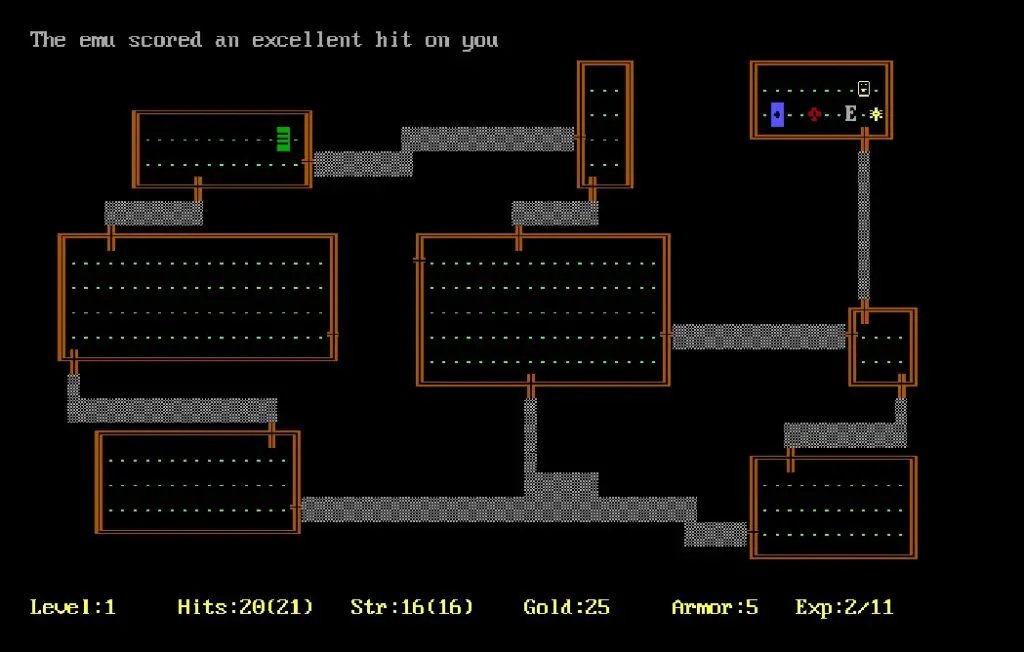
For all the dangers the game throws at you, time, however, is on your side. Rogue is completely turn-based, allowing the player to carefully plan their moves and each swing of their trusty mace. It’s a type of game that requires tactics and strategy above all else. Quick reflexes won’t serve you here, and luck won’t always be on your side.
Although, luck can help. The main feature of the game is its ever-changing dungeon. Some may face a pair of blood-thirsty goblins in the first room. Others, though, an enchanted sword or a healing potion. There’s no use trying to memorize every turn of the maze. It changes each time a new champion enters its halls. This was one of the first uses of procedural generation in computer games. It still is one of the most enduring and recognized features of the genre.
Moria (1983)
On roguebasin: http://roguebasin.com/index.php/Moria
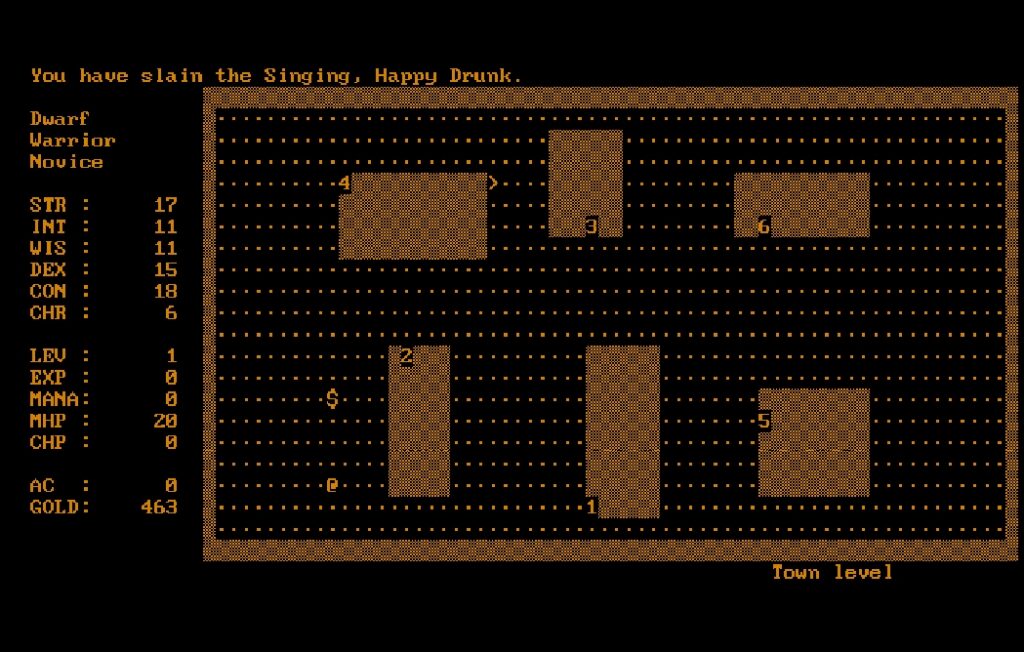
Once again, the hero returns to the dark caverns beneath the earth. This time, though, the twisting tunnels go deeper, the foes are more numerous and the reward is even less certain. However, a sojourn is offered in a form of a poor and desolate town, built at the entrance to the dungeon. There one may find a selection of stores, their owners ready to make a profit from those foolish enough to enter the forgotten depths.
The merchants sell badly needed supplies such as torches, sturdy boots and a warm cloak. In addition to bottles of cheap wine to restore fading courage. A warrior may find a weapon and an armor for himself. There’s also a selection of more arcane goods: books of spells, scrolls of light and rings of defense. All these and more can be bought here at a reasonable price, if one knows how to haggle.
As you finally descend to the Dungeons of Moria, the first thing you may notice after playing Rogue is that the layout is now even more strange and labyrinthine. The, seemingly endless, tunnels turn often and unexpectedly. Almost every wall hides a secret door. These generally lead to abandoned rooms or more empty corridors. Sometimes, you may stumble upon a pile of bones on the floor, a broken sword, or a lonely kobold hiding in the shadows, ready to run at the first sight of steel. The early levels have an almost melancholy feel to them – that of an abandoned fortress, with naught but cobwebs here.
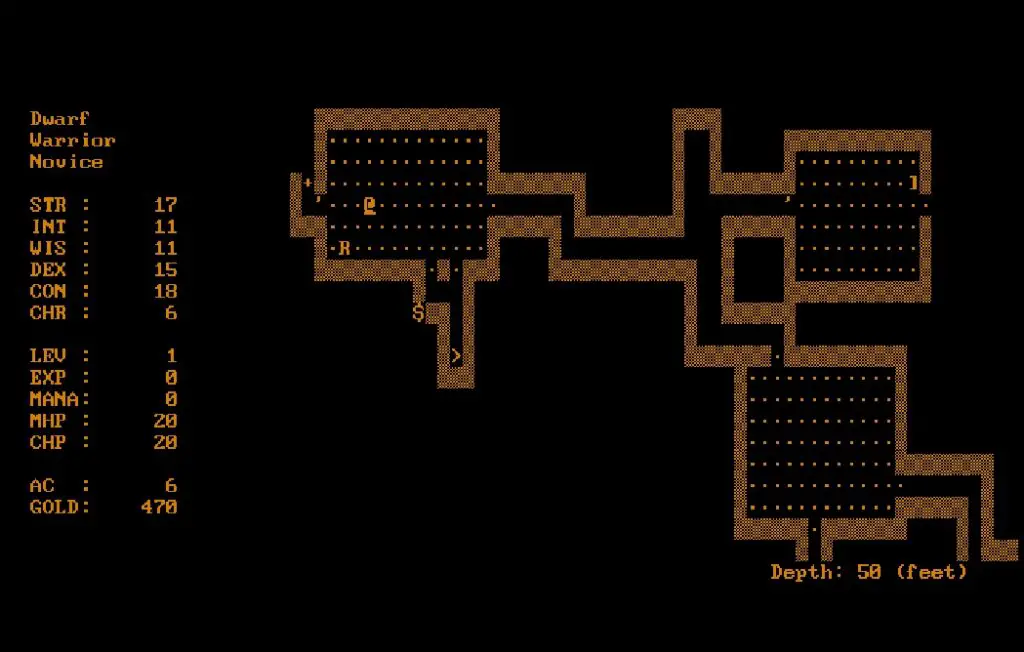
Although it may seem like the old masters have long since left this place, you shouldn’t let your guard down. As you descend deeper, it soon becomes clear that the ancient halls are anything but uninhabited. Orcs and trolls still roam the lower levels. Weird mushrooms cover the ground. While, as you descend, the rooms become full of deadly traps. There is no magical amulet at the end of the journey to reward the hero for the bravery. Only a might foe awaits – the Balrog. Defeat him and you win the game.
Moria is, in many respects, similar to its predecessor with its deep and dark dungeon and a lone hero, fighting against odds to survive its perils. Nonetheless, it adds a lot to the genre with its setting, its occasional humor and its more complex mechanics. It also seems to add some real role-playing elements to Rogue’s straightforward gameplay, with the hero classes and races allowing players to begin their adventure not only as a human rogue, but an elven mage or a grim dwarven warrior. Moria is a true classic that offered everything Rogue did, and a lot more.
Omega (late 1980s)
On roguebasin: http://roguebasin.com/index.php/Omega
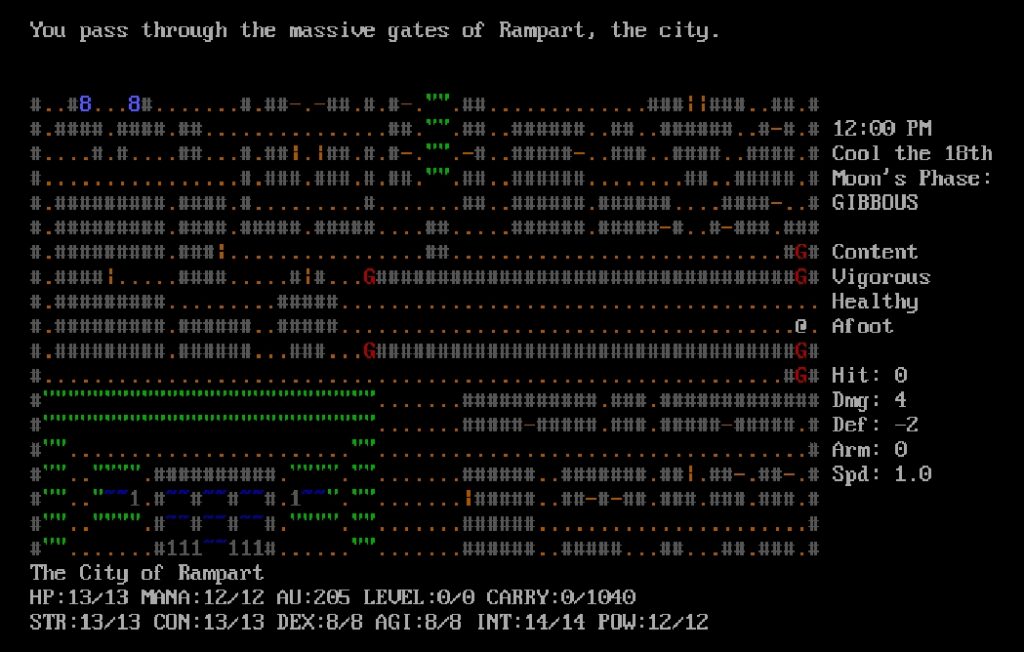
Omega is, most likely, not the first game that comes to mind as one thinks of classic roguelikes. It never attained the fame of other early works of the genre like Hack or Angband. The latter certainly deserve their own articles, but here, being limited to only three traditional roguelikes, I choose Omega. Hopefully, you’ll understand why as we now delve into its dark realm, where sorcerers and gods battle for dominion, and where a lone city stands, in defiance, upon the shores of the Sea of Chaos.
As epic as the story may sound, chances are, you won’t play any significant part in it. Omega is as harsh and unforgiving as any other roguelike of the time, if not more so. You enter the gates of the city of Rampart as a nobody, with nothing to your name but a few coins and no clue of where to go from here. The guards look with disdain as you pass by and then dive into a maze of crooked streets, with their selection of fast-food restaurants, bars and casinos.
As no great quest seems to present itself at the moment, and hunger is as real as ever here, it looks like a good time to find a job. Since the local magical university is way too expensive, the Order of Paladins seems rather unimpressed with your resume, and the guards laugh at you when you try to enter the castle, you end up with a choice of somewhat less reputable sources of income: die in the arena or join the mercenaries.
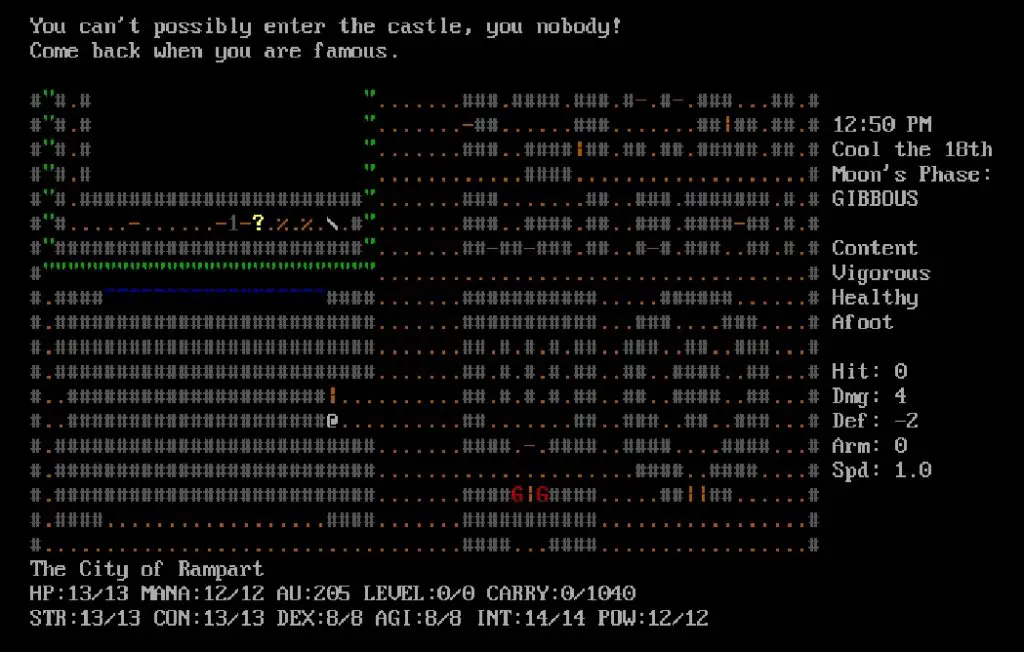
Your future doesn’t become any more clear as Commandant Sonders, the head of the mercenaries’ guild, shakes your hand and congratulates you on joining the Legion. At least now you have a sword and some money, so you may as well stock up on supplies and try yourself at adventuring, exploring the countryside. If you don’t die by getting caught in a chaos storm or by a more mundane arrow in a back, you may be able to reach the first dungeon, and even defeat some goblins therein.
The game has a lot to offer, without doubt: the capital city of Rampart on its own is impressive enough with its vast variety of shops, pubs, guilds and universities. While the countryside hides many other towns and villages, with their own selection of fine establishments. The world of Omega is complex, its story-rich beyond anything seen in a roguelike before. But, just as in this world, an average person will likely never experience even half of its adventures. Here, you’re on your own, and it’s up to you alone to forge your destiny, or die trying.
Summary
Let’s now take a step back and look at these games together, standing, as they are, at the roots of the modern roguelike genre. They share some obvious similarities: the text-based interface, the keyboard input, the fantasy setting. The main character is always alone, woefully unprepared for the dangers ahead. Not really a chosen champion of the gods, one could imagine. Just as in the early editions of D&D, the authors throw you into their worlds, hand you your sword and armor, and then it’s all up to you to die or to survive and ascend to glory.
There may be some standard quest to complete at the end, but, chances are, you’ll never get there. This isn’t the main goal in these games, anyway. The journey is what matters the most. To confront the dangers as a regular adventurer with no great destiny promised to you, and to cut your own path to greatness by sheer determination, is the reward that is offered here. Death is permanent, and often unfair, but that’s how life goes. It makes the experience all the more memorable.
So how do the modern developers compare against the masters of old? Did the genre become too diluted over the years or is there still hope for the traditional roguelike, rough and unforgiving, as it is? My answer to that last question is absolutely! But I’ll let you decide for yourself, as we return now to the present times to take a look at some of the greatest traditional modern roguelikes.
The Modern Times
Tales of Maj’Eyal or ToME (1998 – the first prototype, the latest version released in 2017)
Official website: https://te4.org/
Steam page: https://store.steampowered.com/app/259680/Tales_of_MajEyal/
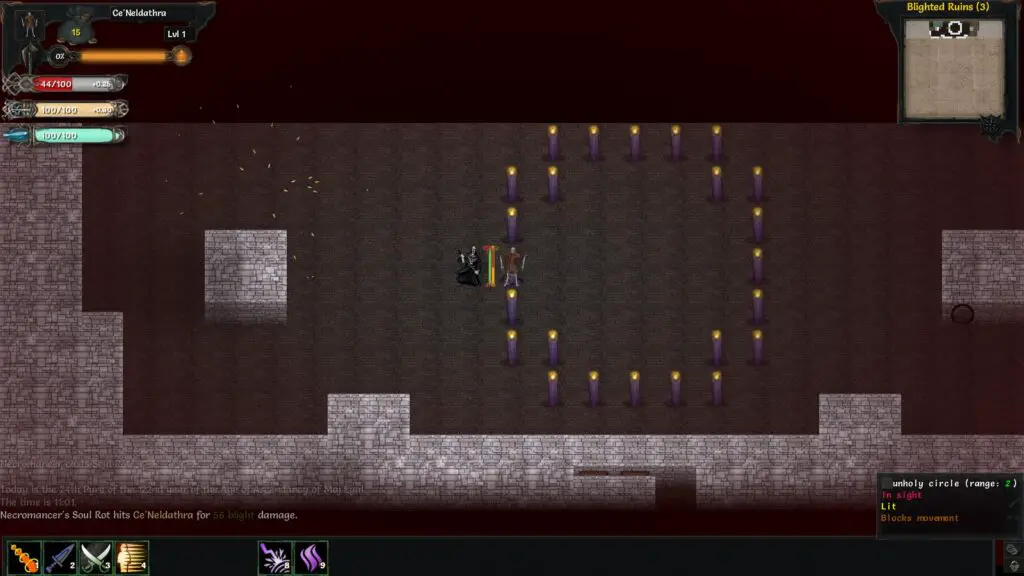
ToME could’ve as well been cataloged with the classics of the 80s and 90s, its first prototype coming out in 1998, built upon the codebase of Angband, which itself was a variant of Moria. Its development spans two distinct eras of roguelikes, and it’s one of the few games that managed a successful transition to a completely modern style, with elaborate graphics, a long soundtrack and an intuitive user interface.
It also has its share of deep procedurally-generated dungeons, in the best traditions of the genre. As you start the game for the first time, it may not look too different from other standard roguelikes, as you battle your way to the last level, faced with an arrangement of traditional fantasy enemies. Even in the beginning, though, ToME shines with its variety of skills, hero classes and mechanics, promising a rich and complex tactical gameplay.
As you finally leave the first area, thinking you’ve got a good idea of what ToME has to offer, it surprises you by presenting a vast open-world, full of towns, dungeons, forests and an array of other unique locations to explore. There is a lot packed into this game, and you ain’t seen nothing yet!
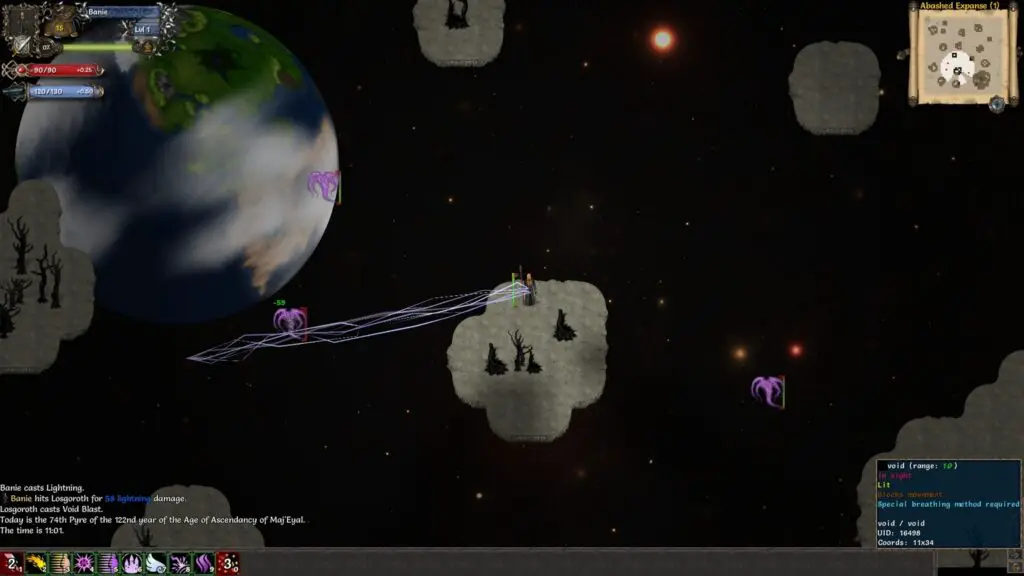
Adventure awaits, and in the mystical realm of Maj’Eyal there is no lack of work for a hero, be they a grim dwarven defender, an elven archer or an undead sorcerer. Each place has its own story. Wherever your journey has brought you – to an underwater temple of the ancient gods, or a dark cavern hidden in the mountains, where orcs await their hour, you always feel completely immersed in the rich and deep lore of that world.
ToME is a true classic from the dark past that has broken its way through to the modern times, without losing any part of its essence. It’s a traditional roguelike with turn-based combat, dungeon crawling and a lone hero, armed to the teeth with weapons and sorcery, facing a horde of blood-thirsty foes, on the road to glory.
Main features:
- A truly large open world, part procedurally generated – part handcrafted, with towns, villages and a multitude of fantastic areas to explore.
- One of the most complex character progression systems seen in a roguelike, with 16 playable races, with their own talents and 37 classes to choose from – each offering its own unique play style.
- A deep tactical gameplay in the best traditions of the genre, with an array of various mechanics, including a variety of magical modifiers, over 100 spells and over 50 effects.
Jupiter Hell (2019, with the latest update in 2021)
Official website: https://jupiterhell.com/
Steam page: https://store.steampowered.com/app/811320/Jupiter_Hell/
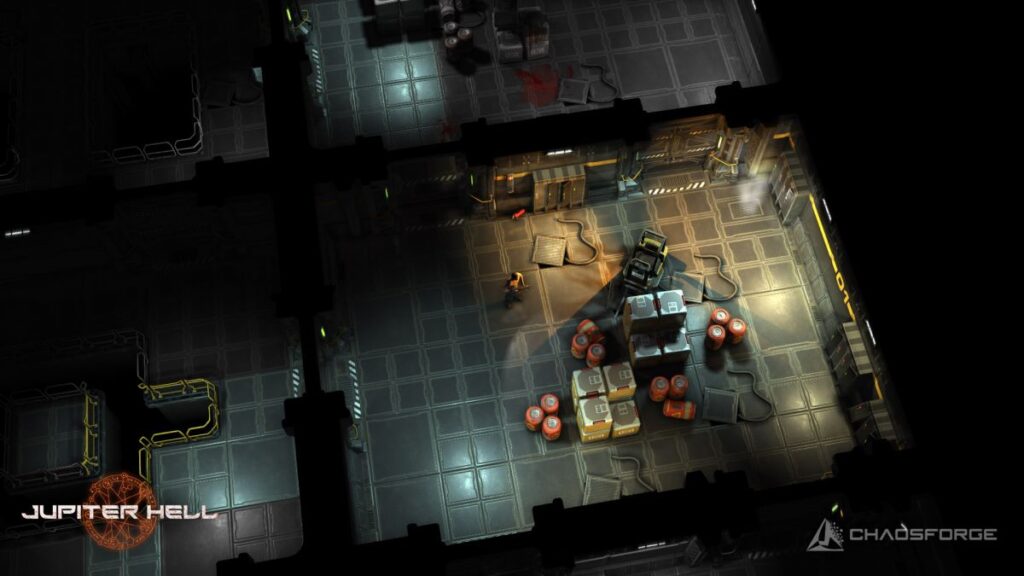
It’s as brutal as it is unapologetic, taking as much inspiration from the classic shooters of the 90s with their heavy metal style as from the true roguelikes of the 80s. The scenery here is that of an abandoned space station, crawling with demons, but it doesn’t really matter as you pick up the shotgun and stride forth across the pools of blood and acid.
There is no respite here, no town to hide in, and no comrades to cover your back. It’s a lot like the original Rogue, really, but taking place in hell with violence cranked up to the max. Jupiter Hell is a traditional roguelike, as pure in its gameplay as in its thirst for destruction.
Even the graphics here is stylized to look like some glowing CRT screen from the times past, with a terminal-like interface in amber hues and a pixelated monospaced font. The author of this game knew exactly what it is he’s making and accepted no compromises as he forged what is, most likely, the one modern roguelike, most true to its origins.
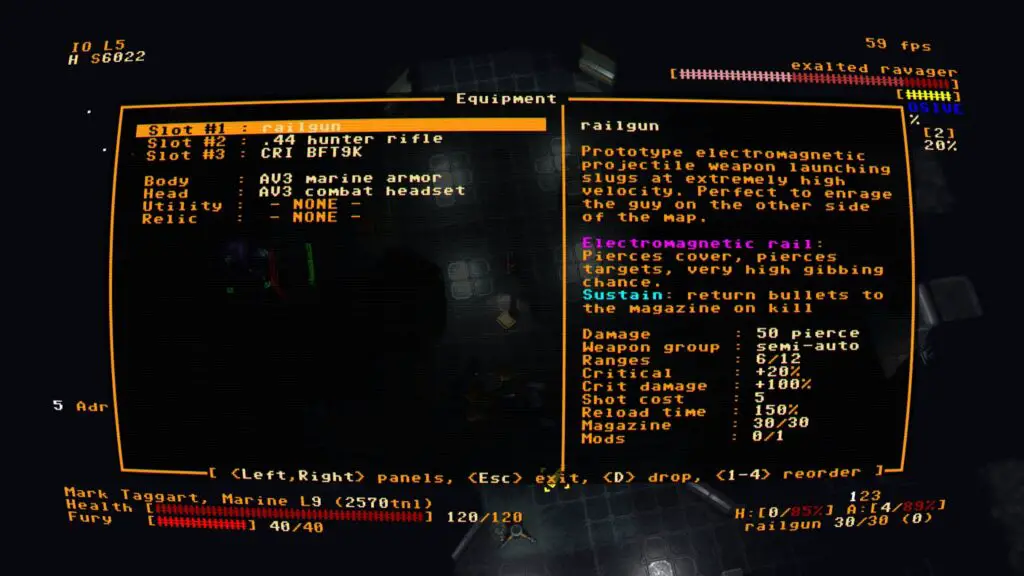
As fast-paced as Jupiter Hell may look at a first glance, it’s still a traditional roguelike at its black heart. It’s completely turn-based, giving you plenty of time to select your preferred method of death to rain upon the hordes of enemies that dare stand in your path, with plenty of weapons, skills, and mechanics to choose from.
Jupiter Hell is a living screaming proof that the genre is still going as strong as ever in its purest form, remaining undiluted in its gameplay even as it abandons the traditional fantasy aesthetics for something way more violent.
Main features:
- An impressive choice of weapons of doom, each more violent than the last, with fitting over the top names for uniques, that seem as if taken straight from death metal song titles, like Bloodletter and Soulstealer.
- A horde of enemies to tear through on your bloody path across hell: zombies, demons and even robots all provide for a nice variety.
- A complex character progression system with three main classes and 37 traits, offering unique advantages and mechanics, each with its own special flavor of destruction.
Soulash (first demo in 2019, still in development)
On itch: https://wizardsofthecode.itch.io/soulash
Steam page: https://store.steampowered.com/app/1623210/Soulash/
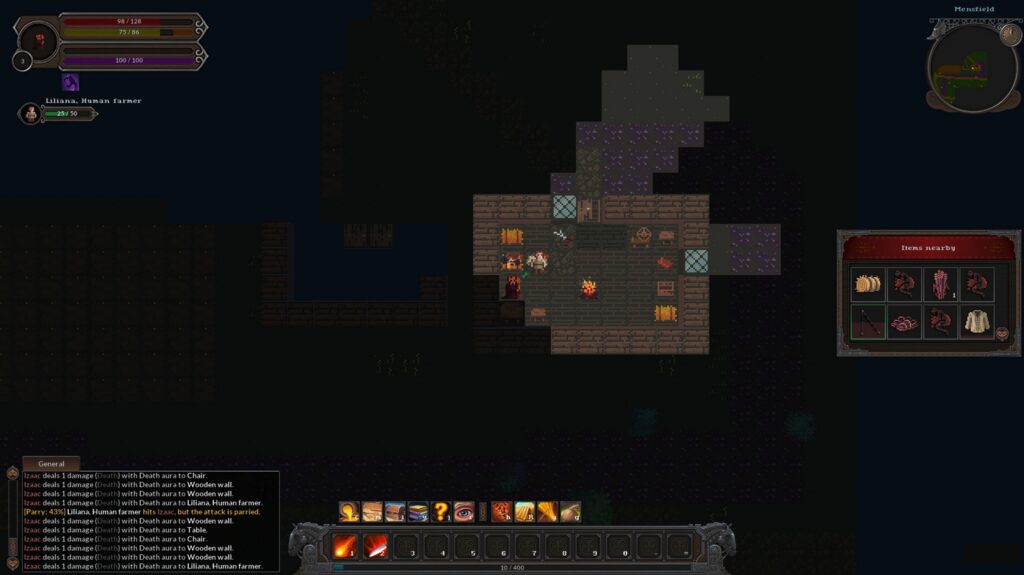
Yet, there are some variations of the traditional fantasy genre that can rival Jupiter Hell, if not in sheer brutality, than in the magnitude of destruction they offer those few chosen, who are not afraid to submerge themselves into the unholy depths of Lovecraftian shadows on the path towards complete annihilation.
A forgotten god from the shadowed past has returned to the mortal world. The cursed bells have rung – an hour of retribution is at hand. The Dreamworld has slumbered in peace for far too long. The new pantheon of traitors shall look with horror as you set forth to collect what is your due.
Soulash is dark. It’s a true Lovecraftian story with a twist: the elder horror is the main character here. Just as in the best examples of the genre, there is no champion of light to hold back the tide of darkness, rising in your wake. There’s no happy end, no great quest to save the realm. Your only purpose is to take revenge upon those who banished you from that world, to wither in shadows for all eternity.
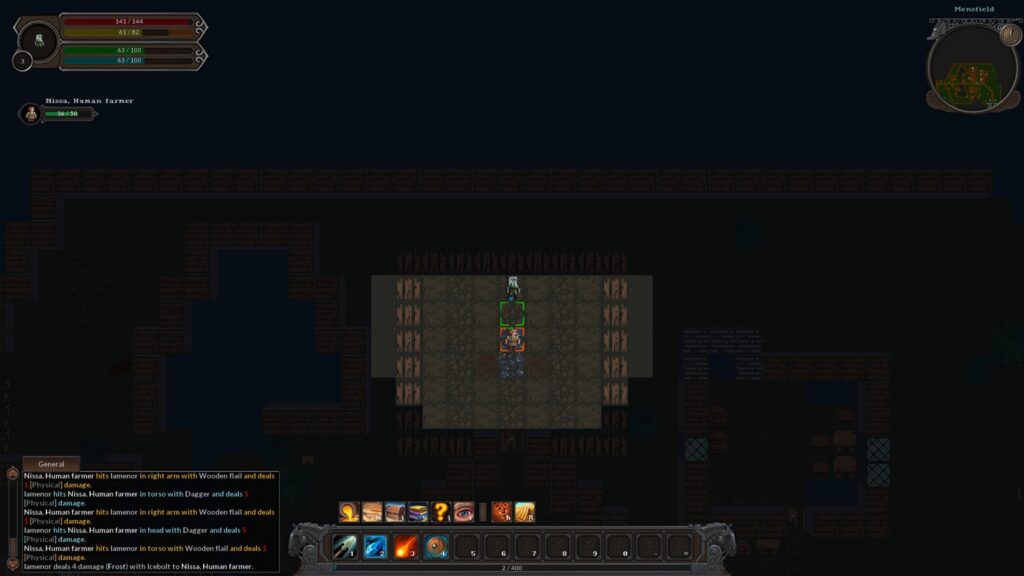
Regain your old might, as you gather the souls of mortals on your grim crusade across its vast open world – and the world of Soulash is truly large, part procedurally generated – part handcrafted it could be placed next to Tamriel of Elder Scrolls in how complex it feels. Each soul you harvest has a name to it and its own story. The characters all seem to live their own lives, be they farmers in a village, knights from a castle in the mountains or travelers upon the road. They all have something to say, and they certainly don’t act like featureless dummies that exist just for some game mechanic.
Not just the characters – the land itself feels alive, with wolves and hares roaming the forests, wild mushrooms covering the ground, fields full of crops, and domestic animals at the village. There is a complete crafting mechanic within the game, with an array of ingredients. Soulash is already a modern classic and the development still continues with each update adding something new to its universe.
Main features:
- A vast open world, that does really feel living and breathing, with unique randomly-generated characters, all the more satisfying to steal souls from, as well as destructible terrain and a dynamic weather system.
- Over 100 skills offering a rich and involved tactical gameplay, as well as a choice of fittingly evil races and professions to choose from. No paladins here – but you can always play as a lich necromancer or a dark elf fallen knight.
- A variety of polished game mechanics that, surprisingly, not all involve death and suffering. There is a whole crafting system to lose yourself in, as you take a break from harvesting the souls of mortals and murder some aquatic life instead, on a nice fishing trip.
Conclusion
We have crawled through dark caverns deep under the earth, found our way on the crooked streets of ancient cities, journeyed across vast fantasy worlds – some full of hope and light, and some falling into ruin. We’ve looked at some of the greatest examples of the roguelike genre. Now, we’re at the end of our adventure and it’s time to look back, and at last come to a conclusion. What makes a Roguelike what it is, and do the modern games have what it takes to be placed next to the classics?
Roguelike is, certainly, a strange genre, apart from others, with its roots going far back in history, its origins hidden among the mists of time. There was no big company dictating the rules of the game, no clear authority has carved the guidelines upon stone tablets. From the beginning, its developers did as they felt like, taking inspiration from a startling multitude of sources, without much regard for marketing or target audiences.
Many things that are now strongly tied with roguelikes, like the text-based interface, the keyboard controls, were as much a result of limitations of the machines of the time as of creative inspiration. The look and feel of the genre has changed, for sure, but is it still the same genre after all these years?
You can decide for yourself I’m sure as to what the answers are. To me, however, there is no doubt that today the traditional roguelike is as strong as it has ever been.
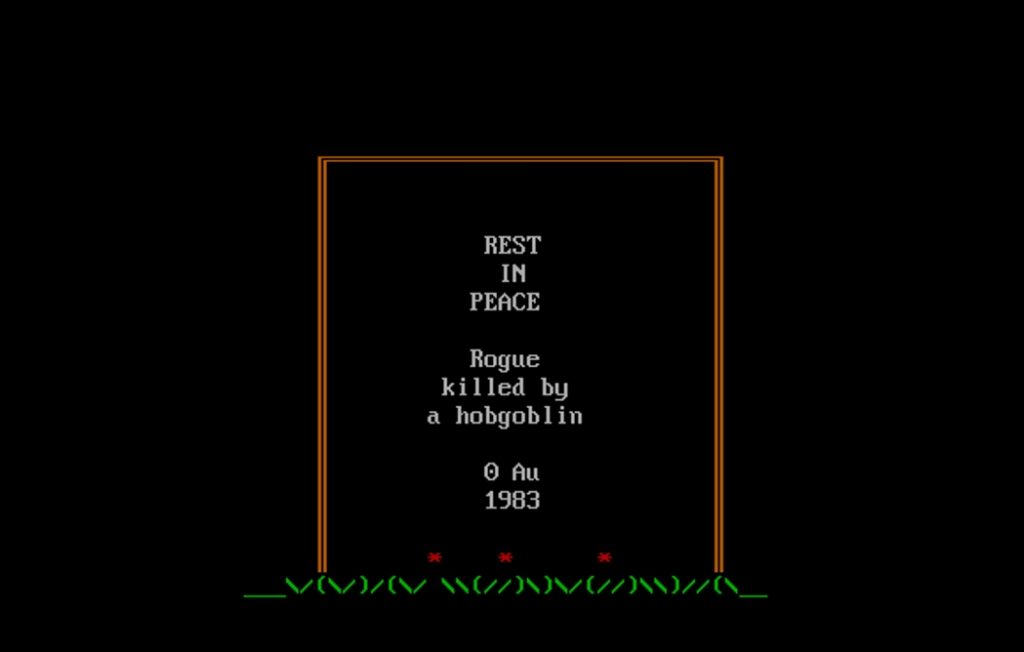

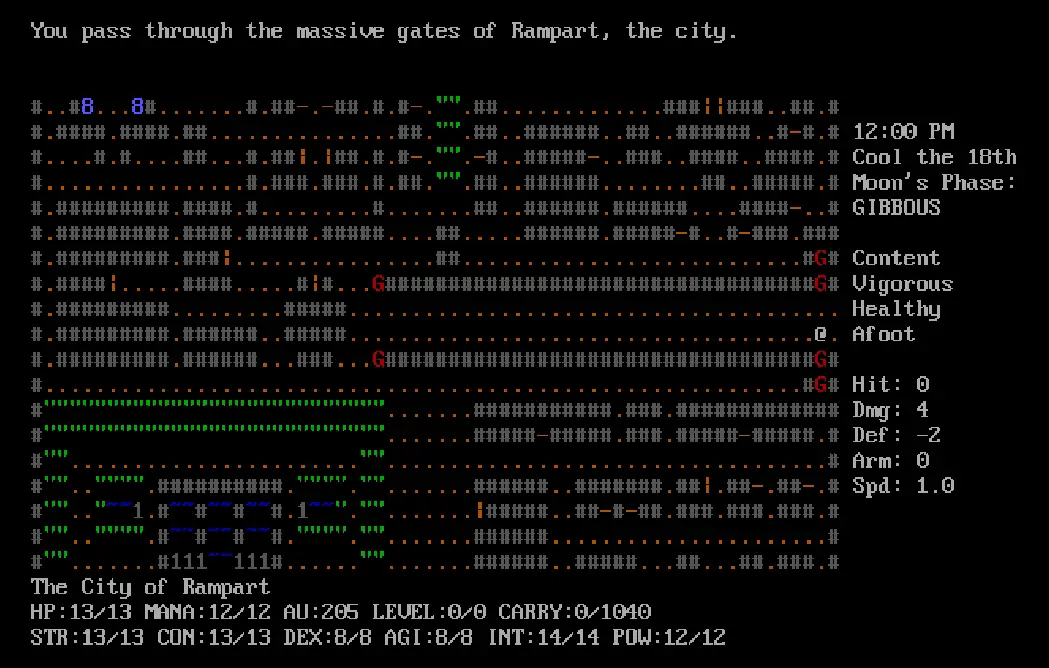






What about Cogmind?
Do not worry! I’m already working on the next part.
Was going to write the same 😀
I have never read so many beautiful words put together to describe my game. Thank you.